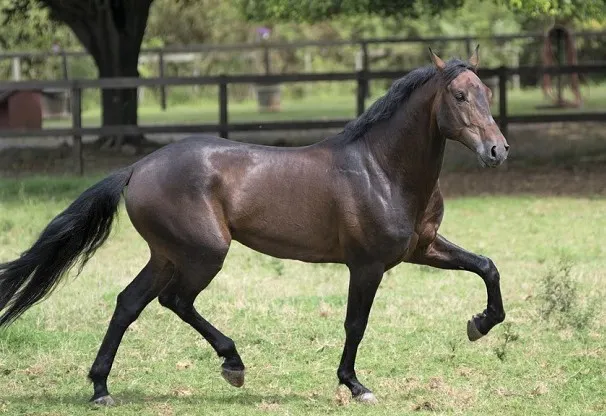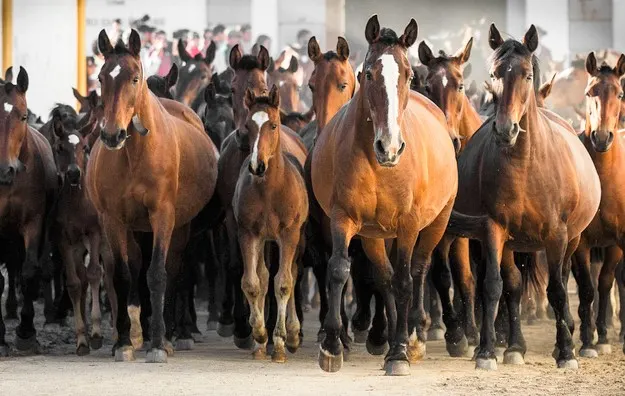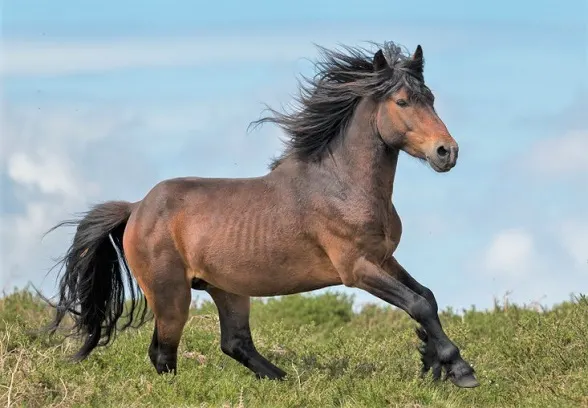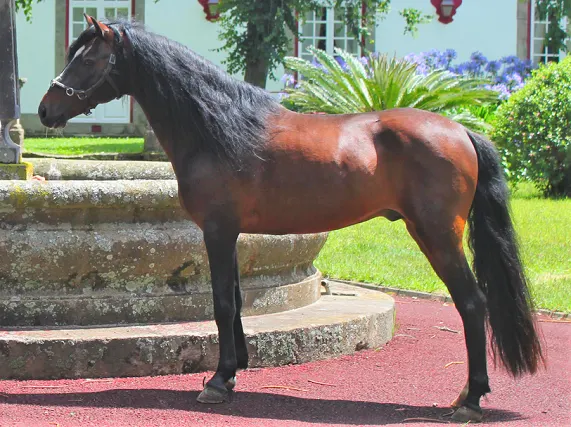This post may contain affiliate links. We earn from qualifying purchases. Learn More
From stunning beaches to charming cities, Portugal is a beautiful country. This picturesque country also has some of the most exquisite horse breeds.
Portugal is home to a handful of beautiful horse breeds, many of which have long, rich histories and share close ties to Spain. These incredible horses are an important part of Portugal’s culture. The native Portugese horse breeds include the Lusitano, Sorraia, Alter Real, Garrano and Terceira.
Here are the five stunning Portuguese horse breeds.
Lusitano

The pride of Portugal, the Lusitano is one of the earliest saddle breeds in the world. With a riding history tracing back 5,000 years, these majestic horses were once noble war mounts.
Since around 20,000-30,000 BC, horses have lived in the Iberian Peninsula. As civilizations rose and fell, these ancient horses were influenced by horses across the world. By 800 BC, the Iberian people relied on their horses as fierce war mounts.
Iberian horses soon become popular for bullfighting and were a favorite among the wealthy. As the art of classical dressage blossomed in Europe, they were considered the superior mount of choice. In Portugal, the breeding of these horses focused on dressage, cattle work, and mounted bullfighting. However, in Spain, breeding focused on a more flashy, elevated horse.
The Lusitano shares the same heritage as it Spanish counterpart, the Andalusian. In fact, until the 1960s, all Iberian horses in both Spain and Portugal were Andalusians. It wasn’t until 1966 that the Portuguese and Spanish stud books split, and the Portuguese strain of the Iberian horse became the Lusitano.
Powerful yet elegant, Lusitanos are a ‘baroque’ type of breed, with a well-muscled body, arched neck, and powerful hindquarters. They are famous for their intelligence and bravery, allowing them to excel at many things such as dressage, driving, working equitation, and much more.
Lustanios generally stand around 15-16 hands tall and can come in any solid color.
Sorraia

Named after the Sorraia river which flows in the lowlands of Spain, the Sorraia is an ancient horse breed. They are direct descendants of the indigenous South Iberian wild horse of Portugal.
Though their true origins are unknown, there are many theories as to how these unique horses came to be. Images of horses with a distinct likeness to the Sorraia have been discovered in Palaeolithic art. Scientists are currently studying these horses to see their relation to other wild horse breeds.
It was believed that the Sorraia breed was extinct until 1920 when zoologist and paleontologist Dr. Ruy d’Andrade encountered the horses while on a hunting trip in the Portuguese lowlands. After his finding, d’Andrade began a breeding program with five stallions and seven mares. While closing studying the horses, it became clear they played a large role in the development of the Lusitano and Andalusian.
Today, there are only around 200 Sorraia horses. These hardy horses have a convex profile, deep chest, and stout legs. They stand around 14 hands tall and are dun or grulla in color with primitive markings. Sorraias are versatile horses, as their uses include dressage, endurance, bullfighting, and herding.
Alter Real

The Alter Real is a specific strain of Lusitano horses. Developed in the 18th century, these special horses were a favorite among royalty.
The word ‘Real’ translates to royalty in Portuguese and ‘Alter’ refers to Altér do Chão, a town in the Alentejo province of Portugal. In 1748, the House of Braganza in Villa do Portel developed the Alter Real horse as a carriage and classic equitation horse for the Royal Stables at Lisbon.
In 1756, 300 Andulisian mares were introduced into the breeding stock. When Napoleon invaded Spain in the early 19th century, Arabian, Thoroughbred, Spanish-Norman, and Hanoverian blood was introduced into the breed. However, this led to the breed deteriorating, which led to the introduction of Andalusian blood again.
After the dissolution of the Portuguese monarchy in 1910, the breeds numbers fell once again. Fortunately, Dr. Ruy d’Andrade stepped up to preserve the Alter Real and save them from extinction. Today, all Alter Real horses come from the Alter Real State Stud.
The Portuguese School of Equestrian Art exclusively uses Alter Real horses for Classical Riding. Today, these elegant horses are a favorite for dressage and driving. They have a build similar to Lusitanos, though they have a straight profile, smaller heads, and tend to be more animated. Alter Real horses are either bay or brown in color and stand around 15-17 hands tall.
Garrano

An ancient breed, the Garrano pony has remained largely unchanged for thousands of years. In fact, they are believed to be the horses depicted in Northern Iberian Paleolithic cave paintings.
The Garrano has long held a close relationship with the people of the Minho region. The people relied on these hardy ponies for farm work and transportation through the steep local terrain. Throughout history, the Portuguese Army has even utilized Garrano ponies, including in WWII.
For centuries, they have lived in wild and semi-wild herds. Garrano ponies have influenced other breeds including the Galicia Mountain Pony and Cirillo. In the 20th century, Arabian blood was introduced into the ponies.
Today, most Garrano ponies live in the wild in the mountainous regions of the Minho and Trás-dos-Montes of northern Portugal. They have a thick neck, muscular body, and strong hooves. They generally stand around 13 hands tall and are often bay, brown, dark chestnut, or grey.
Terceira

Native to the Terceira island of the Azores Islands in Portugal, the Terceira Pony is a newly recognized breed. Originally known as Azores horses, they were an important part of the colonization of the island.
Though not much is known about their background, it is believed that Alter Real and Lusitano horses imported to the island during British colonization played a role in their development. However, despite this, there is very little formal documentation and the analysis of the breed is still unclear.
Today, Terceira ponies are popular tourist attractions on the islands. The locals also use them for driving and riding. Their sturdy builds have allowed them to adapt to island living.
Terceira ponies have a sturdy build with high-spirited yet reliable temperaments. They generally stand around 11-12 hands tall and are often bay in color. Though they are pony size, their conformation is similar to that of a lean, athletic horse.


Rita Faulkner
Wednesday 24th of November 2021
Where can I find a Terceria pony?